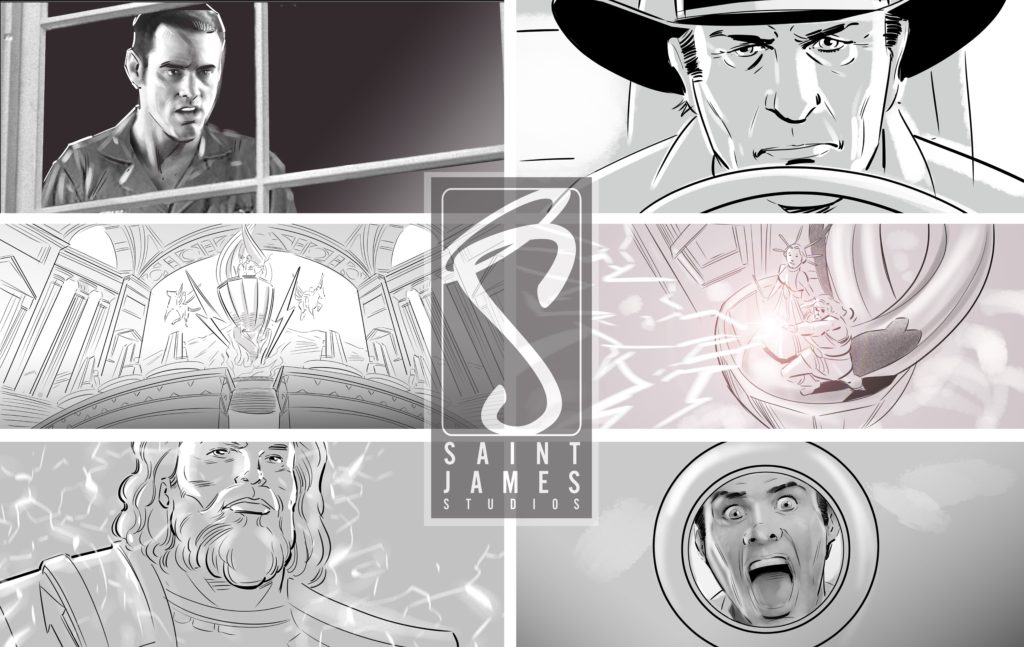Is creativity magic? Nope. It’s mostly hard work. My creative process is something I do for every single job — but it’s not something I’ve shared before. Recently, a director told me he’s never worked with a storyboard artist who has a process like mine, so I thought I’d share it.
Without further ado, here’s my process when creating storyboards:
1. Reviewing the script (and tuning into the director’s vision).
A lot of artists draw first and write later. As someone who started out in comics and still creates comic books, I believe in the written word. For my own work, I write first, draw later. The great thing about the agency script and the director’s treatment is that I’m getting the pure adrenaline version of the spot. Although it may change, I know what they felt and wanted in the moment it was written. I want to honor the director’s ideas — and they are inside the written word.
2. Talking to the director.
In our first call, I’m finding out their feelings about the script. What is their vision? Do they have ideas that are divergent from the script? I love to see a director work their magic and really nail the script — and I do everything I can to make that happen. Throughout the process, I’m in close contact with the director the entire time.
3. Character study & research.
With script-in-hand, I’m thinking about the frames, the characters’ facial expressions, and their body language. With Super Bowl especially, 9/10 times it’s famous people starring in the ads. You can draw storyboards without the subjects looking like the actors, but to me, likeness is important. The boards aren’t just for the director or crew — they’re also for the actors. In my mind, Jim Carrey might be the one actor who cares how he looks in a storyboard! I want to do him justice. So my research is a character study about the actors’ faces, and how they move their bodies. In recent years, we are thankfully seeing more diversity in the casting of commercials. As an artist, I love to represent different ethnicities — and my research helps me accurately depict diverse characters authentically, which again, is so important to me.
Drawing Jim Carrey for Verizon has actually made me a better illustrator; his range of expression is so intense!
4. Drawing (intensely).
This part is intense. It’s fast. It’s immersive. I take all the words, conversations, insights, and nuances and draw. I go into a zone. I usually start around 4:30 AM and come up for air when it’s finished. Sometimes I start when it’s dark, and finish when it’s dark. Sometimes I’m drawing 60 or 80 frames. Music is playing. I’m standing. I’m sitting. I’m using all of my creative energy in visualizations, lines, and brush strokes. My drawing program tells me I’ve drawn 5 miles of lines — and I feel every bit of it in my body. Creativity is hard, and it’s special, but it’s not magic. You’ve got to respect your tool.
One of my favorite things to draw is cars. I loved drawing the boards for Toyota’s Super Bowl commercial starring Tommy Lee Jones, Leslie Jones, and Rashida Jones.
Toyota: The Joneses Commercial
5. Getting notes & refining (quickly — while keeping things organized for the client).
The agency’s notes. The director’s notes. Often these involve changing the location or actor after something falls through. Sometimes the notes are more detailed, like, put the phone in her other hand. I try to send the frames and set up the files so it’s all making sense, with easy access — because I know the crew is getting down to the wire. We’re all working together as a team.
For BMW starring Salma Hayek, one of my favorite actors of all time, I had an unusual edit, but I’m not allowed to discuss it here. Call me and I’ll tell you!
6. Relax & Recharge.
I know success has been achieved when my email and phone go silent. I enjoy the silence, do something soothing like washing the dishes, then hang out with my family, and maybe watch a movie. Then I zonk out and do it all again in the morning.
I had the privilege of working with Bryan Buckley — The King of Super Bowl — on all three of his commercials this year. It’s always a pleasure learning from him.
Let me put my creative process to work for you. Let’s talk about your vision.


 Producers…Hire the right storyboard artist (or regret it later).
Producers…Hire the right storyboard artist (or regret it later). Directors…Which Style Storyboard Do You Prefer?
Directors…Which Style Storyboard Do You Prefer?